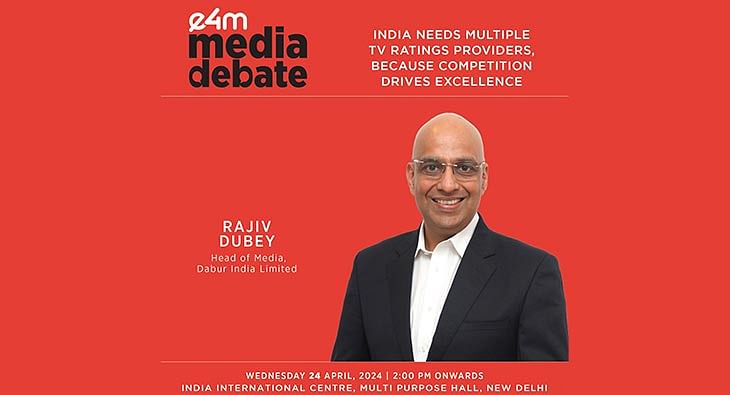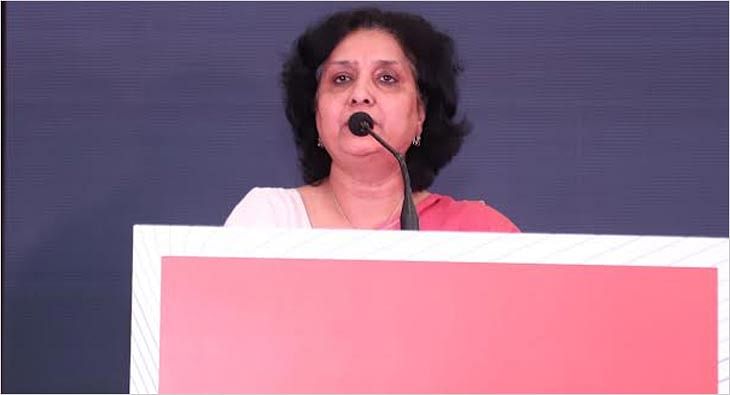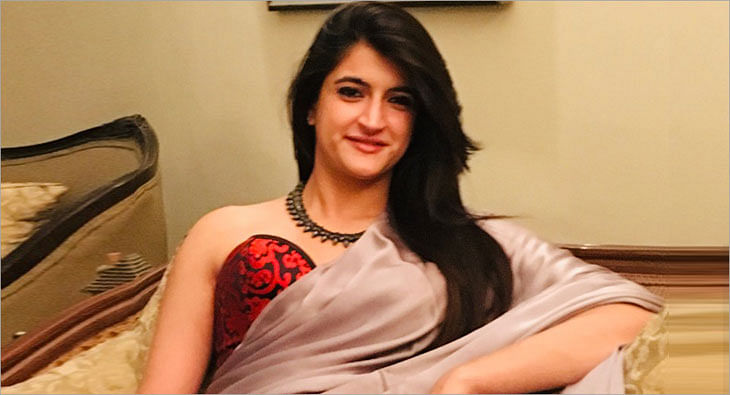Indian television's relationship with its political class is changing: Arnab Goswami
Political parties have woken up to media. But we journalists will have to be on our guard to see that we are driven by our own judgement & not that of political parties, says Times Now's Editor-in-Chief in an exclusive conversation

In an exclusive conversation with exchange4media, Times Now Editor-in-Chief Arnab Goswami talks about significant changes in the mindset of political parties towards media, sustaining the channel’s momentum in the post-election period and more. Excerpts…
Do you think the objectivity in the poll coverage was lost once it became clear that BJP and NaMo were gaining the upper hand?
No, I don’t think so. If you examine the number of times a news channel went to Rahul Gandhi, it was more if not equal to the number of times it went to Narendra Modi. In terms of coverage on ground, we covered Congress, BJP and regional parties fairly. The number of rallies Modi did far outstrips the number of rallies Rahul Gandhi did, so there was more to cover. But if we were taking a live feed of a Modi rally, we would also take a live Gandhi rally. When Rahul Gandhi said something that set the news agenda, it was debated with as much enthusiasm as Modi’s speeches. For example, Rahul Gandhi made the controversial remark on what happened in 1984 - it was debated for a week not only on Times Now that did the interview, but on all channels. Similarly, if you see the number of times his interview was replayed and the promotion it was given, it is possibly the same as the treatment given to Narendra Modi’s interview. Both the interviews got talked about. So, I would argue with all the force at my command that the media did a very objective job till the very end.
Do you think this was truly a media election?
I think it was certainly a television news election - the quality and depth was far ahead of the poll coverage in 2009 and 2004, and I have seen all elections from 1996. This time, we actually put people who were fighting the elections on the backfoot, defending the subjects they raised. The media had an aggressive questioning approach. Of course, there were many other channels and much more competition, and competition begets quality, broadly speaking.
In a recent interview with IMPACT, NDTV’s Prannoy Roy said, ‘You can’t win elections in India any more unless you are an acceptable face of television’. Do you agree?
Prannoy is a leader and I have had the pleasure of working under him at the beginning of my career. I am sure what he says is said after great thought and I generally would not like to add anything to what Prannoy says, but only because you ask, I think political parties have started acknowledging the fact that their message needs to go out, in as clear a way as possible. The people who carry those messages don’t make mistakes, and therefore, the search for people who can represent the party’s view aggressively on TV. If you follow the career profiles of some of the party spokespersons, they go on to do very well in the party later. The party understands the need for effective people articulating their view. If you have the wrong person communicating on behalf of your party, a completely wrong message can go out, and ruin the reputation of the party. So, to a large extent I would agree with what Prannoy said.
What are the changes you saw among political parties during the recent elections as far as approach to media was concerned?
The election campaigns were drastically different from the previous years - there were media cells in each party. In fact, they would call and ask us about the subject for that night’s Newshour. They would try to find out who was there from the other side, try to match each other every evening on prime time. They would actually come to us with their best spokesperson.
Political parties have woken up to media. They will try to do everything possible to ensure their point of view goes across more prominently, but journalists like us will have to be on our guard to see that we are driven by our own judgement and not that of political parties.
What worked for you during Elections 2014? What was the approach you adopted while covering the elections?
Television news is an interesting confluence of graphics, production, news, promos, look and feel, editorial line, logistics, reporter placement, optimisation of available infrastructure and editorial angularity. Now why did we win by such a massive margin? The gap between us and the nearest competitor, which is CNN-IBN, in the male TG 25+ was over 20 per cent. I think it is because we got the mix right. We were able to create an editorial product that gave a completely different viewing experience, beyond comparison with any other channel in the vicinity.
Secondly, we were covering the elections with greater force. For almost three months, there was nothing but politics on Times Now, to be able to sustain that over a 100-day period with the same team means you need to get commonality of purpose within every member of your team. I am so delighted today that this group of people worked double shift, triple shift, non- stop... I had people who worked days on end, some who did not go home for weeks to put this product out. While I may be the most prominent face of the channel, it is this team that made it happen - they have done a phenomenal job. Our guest coordinators did a great job, we had over 1,000 guests and around 50 guests a day.
What also gives me most satisfaction is we were the only channel not based out of New Delhi or the national capital region that was covering this election. Our studios were in Delhi, our servers were in Mumbai, our anchoring was in Delhi, our graphics were in Mumbai, to bring technologies in two cities together on a pipe with limited infrastructure is a marvel of election broadcasting. I can share with you today that till the very end, we were very nervous whether it would all come together. It worked like clockwork. This coverage is one of the high points of the eight-plus years of broadcasting of Times Now. Wherever we went this time, people said they were watching the election completely on Times Now. On an average, they would say they spent 10 minutes on Times Now and not more than 1 minute on any other channel. We gained because of our production quality; we were breaking all the news first, and had a great quality of panelists.
What is the ideal mix for a television story?
There is no ideal mix... it is ‘the mix of the moment’ you think of right ingredients of the story of the moment. The team is tested on its ability to respond to the changing news flow. I have often said that TV is like the permanent first page of a newspaper, where the front page changes every five minutes.
Times Now also scored on the social media front in poll coverage. How did you plan your social media strategy?
We had a deal with Twitter, and Rishi Jaitley was very responsive to it. There was an exclusive arrangement, where we could get a real-time analysis - positive and negative feedback, link Twitter with the Newshour debate, understand how many people were feeling positively and negatively towards it. Did it lead to an increase in ratings of Times Now? I am not sure. But it did involve people on social media further with Times Now. In the last four to five months, we have grown perhaps at four or five times the speed of any of the other channels such as CNN-IBN or NDTV on social media. From being less than half their size on social media, we have crossed the gap in four months.
What are you doing to sustain the momentum?
We are far faster than any other channel on social media, with our updates and we have high involvement products like ‘Newshour’ and ‘Frankly Speaking’ which are integrated with social media. Two out of every three days, the top trending subjects are Newshour hashtags or TimesNow hashtags. This proves that in terms of talking points and mindspace, we are streets ahead of competition. This election gave us the opportunity to display our editorial muscle, in terms of social media, we are going to take it forward now and we are going to be twice the size of any other channel on social media. It is going to be a great area of focus. The quality of news broadcasting is going to gain from our coverage of the elections. The challenge is to sustain this level of interest in the post-election period. A politician asked me ‘What are you people going to do now?’ and I replied, ‘We are not as dependent on you as you would like to think!’ Yes, we are making the political class accountable every day. Our coverage of Uttar Pradesh is not political coverage, it is social coverage. We are not in the business of politician-bashing, we are in the business of making elected and unelected (it does not end with an election) politicians feel accountable.
What is the gameplan for Times Now going forward?
On a scale of 1 to 10, if our closest competitor is 1 or 2, we are 9 or 10 in terms of engagement of the viewer. I believe no other channel comes close to us in the matter of engaging the viewer; so I believe it has to have a natural follow-up. It is very interesting that on days of great performance on the IPL, we are more talked about, in terms of the subjects we speak about. We have given even sports channels a serious run for their money in terms of audience engagement. It is an area which I am excited about; I enjoy myself when I know I am learning something and social media is teaching me a lot, and I have a fantastic young team.
Read more news about Television Media, Digital Media, Advertising India, Marketing News, PR and Corporate Communication News
For more updates, be socially connected with us onInstagram, LinkedIn, Twitter, Facebook Youtube, Whatsapp & Google News
The current ratings system lacks trust: Rabindra Narayan, PTC Network
During the recently held e4m media debate, Rabindra Narayan, MD and President, PTC Network, spoke for the need for multiple TV rating providers
The current system of ratings by BARC lacks trust and credibility, said Rabindra Narayan, MD and President, PTC Network, at the e4m debate on Wednesday while asserting the need for multiple rating agencies in the broadcast ecosystem.
The e4m media debate on ‘India needs multiple TV rating providers because competition drives excellence’, held in New Delhi, was chaired by Anurag Batra, Founder of e4m and Editor-in-Chief of Businessworld Media Group.
During the debate, Narayan, who was speaking for the motion with other panellists, questioned the Broadcast Audience Research Council (BARC) ratings, particularly for news channels saying that politicians spending money to advertise on news channels and not GECs, is proof enough that the genre is doing much better than the ratings given by BARC.
“The fact that we are having this discussion, implies that the current system lacks trust. It lacks credibility. BARC analyses only linear TV that is beamed and received through satellite and cable. TV viewing today is not just linear TV, it also has several forms like connected TV and Fast TV coming on the same screen but BARC is not measuring it,” he said.
Narayan further said that it was time to innovate and look at content rating rather than just television rating points.
“As per BARC, news genre reach is 6-7% in the entire country, if that is true then why are politicians eager to spend on advertising on news channels? Why not on GECs? Why all the money spent by advertisers to reach maximum consumers, based on this Bible (BARC) which is junk? Why are we fighting for TV rating points and not content rating points when the technology and the system is changing?
“The current system of ratings (by BARC) is flawed, biased as it is controlled by a handful of people. Broadcaster lobby is controlled by four business houses so it will always remain in their favour. The data shows it,” he argued.
In his concluding remarks, Narayan said that BARC needs to improve and for that it does not even need to invest in more meters than it already has because cable operators and DTH are now digitised.
“They don’t even need to invest more. They don’t even need more meters than the ones installed already because every cable operator is now digitised and has two-way addressable communication available,” he said.
e4m Media Debate 2024: Call for multiple ratings agencies to break monopoly
Industry players discussed the authority of the current ratings system and whether having multiple agencies will cause increased complexities, discrepancies and expenses
Indian TV news media and advertisers today rely solely on the data released by the Broadcast Audience Research Council (BARC) India to strategise media plans and budgets.
Hence, many suggest having multiple rating systems which will allow for a more nuanced understanding of viewership patterns across different demographics.
Rabindra Narayan, MD and President, PTC Network; Mona Jain, Chief Revenue Officer, Zee Media, and Karthik Sharma, Group CEO, Omnicom Media Group believe a multi-ratings system will drive excellence amidst competition.
On the other hand, multiple ratings systems may also present challenges such as increased complexity, potential discrepancies in ratings, and higher costs for broadcasters as well as advertisers.
The current system of ratings is “flawed” and “biased, as it is controlled by a handful of people,” was the view of the industry veterans who advocated the need for multiple rating agencies instead of just one, which is currently the BARC, saying “monopoly makes people complacent”
During the debate, things got intense when some of the panellists, who were speaking for the motion, questioned BARC ratings, particularly for news channels saying that politicians spending money to advertise on news channels and not GECs, is proof enough that the genre is doing much better than the ratings given by BARC.
To present a viewpoint against the motion, Chintamani Rao, Strategic Marketing and Media Consultant, Rajiv Dubey, Head of Media, Dabur India, and Varun Kohli, Director and CEO, Bharat Express News Network joined the debate at e4m’s Media Debate in New Delhi. Dr. Annurag Batra, Chairman and Editor-in-Chief, BW Businessworld Media Group and Founder, e4m Group, chaired the debate.
Jain opened the discussion and said, “There is a dependency of an advertiser to take up a particular media plan via the agency. On the other hand, the broadcaster is absolutely at the mercy of the measurement system which decides where you rank. The issue is nobody looks at what the reality on ground is. Hence, I have started telling agencies and advertisers to also look at my digital platform’s ranking but the rating in BARC still holds significant value for them.”
She further suggested we should have an authenticated, validated, acknowledged currency which is recognised and valued by advertisers and agencies as well.
Presenting an opposing stand, Rao explained, “There many doubts about BARC and its functioning but I continue to maintain that audience measurement is no business of the government.”
At the end of the day, it is not about the number of vendors but how they are managed. Two poorly managed are not better than one, he added. The key issue is that BARC is dominated by one of its constituents and that is the one which is being measured.
“If advertiser’s money fuels the entire media ecosystem, why did they accept a structure with Indian Broadcasting & Digital Foundation (IBDF) at 60 percent?” questioned Rao.
Sharma, who joined virtually, expressed that if we forget the industry for a while, why do we need the NSE and BSE? Why do we need CIBIL and Experian? The short answer is innovation and competition. If there would be no competition, we would have one brand in every category we operate in.
“Even in a market like the USA, which has the largest AdEx market, there are two systems. Even the UK, Australia, Malaysia, Philippines and so many more countries have two audience measurement systems. In a largely populated country like India two systems will help in better sampling and segmentation,” he added.
Dubey took the stage right after and spoke about how one, two or multiple rating systems don’t matter to an advertiser. At the end of the day, it should help the brand sell. His objective is to reach out to the consumers in the cheapest possible manner.
“The idea of BARC was to have a robust system which could measure everyone well. Have we been able to do that? Probably yes or probably no,” he said.
With changing times, the audience needs have changed and NCCS was a system that measured the class of people based on the ownership of consumer durables. But now, the newly proposed ISEC fulfils those gaps.
Consumers have also started consuming content on different platforms, more towards digital and OTT. Dubey believes, “We haven’t been able to measure that audience correctly yet. Hence, the Indian TV industry needs one system and that system needs to be strengthened in such a way that it measures TV and digital audience equally.”
On having multiple audience measurement systems, the Dabur spokesperson said, “To solve the problem, you should not create another problem, but fix the problem instead.”
Narayan of PTC, who stood for the motion, expressed, “The fact that we are standing here and debating the issue, implies the current system lacks trust and credibility. We are also setting the premise that by TV ratings, we only mean linear TV ratings because that is what BARC does.”
He further shared that BARC does measurement via image mapping and hence, when any channel puts its watermark on any platform, it should become measurable for BARC since they already have the technology for it.
“Then why don't they? Because they need more focus on analysis, not more investment. The trouble is the ecosystem is not allowing the expansion of those ratings,” he added.
Today, BARC says 9 out of 100 people watch PTC, which is impossible and advertisers bargain for the ad rates accordingly. The channel today continues to invest in good shows but advertiser interest is low due to BARC’s data. If there is any truth to this, why wouldn’t players like PTC fight for multiple ratings systems?
“When Chandrayaan was launched, everyone in the world and India was watching it but if you see the BARC data, that particular week the ratings of the news genre went down. Is that even possible? News genre is much higher than what BARC is projecting,” Jain added.
Even on a day like the launch of Chandrayan, there was no spike on BARC data. Jain and Narayan both believe the current system is flawed and biased because it is controlled by a handful of people.
“The fact that we are having this discussion, implies that the current system lacks trust. It lacks credibility. BARC analyses only linear tv that is beamed and received through satellite and cable. TV viewing today is not just linear tv, it also has several forms like connected TV and Fast TV coming on the same screen but BARC is not measuring it,” Narayan said.
Narayan further said that it was time to innovate and look at content rating rather than just television rating points.
“As per BARC, news genre reach is 6-7% in the entire country, if that is true then why are politicians eager to spend on advertising on news channels? Why not on GECs? Why all the money spent by advertisers to reach maximum consumers, based on this Bible (BARC) which is junk? Why are we fighting for TV rating points and not content rating points when the technology and the system is changing?
“The current system of ratings (by BARC) is flawed, biased as it is controlled by a handful of people. Broadcaster lobby is controlled by four business houses so it will always remain in their favour. The data shows it,” he argued.
Kohli of Bharat Express, said, “BARC came into existence because publishers wanted a different rating system and then a mechanism was conceived. Now, questioning that system just because ratings aren’t in the right proportion or it doesn’t map digital audiences and to further ask for a separate body, I dont think is the right way.”
The industry needs to come together and exercise jurisdiction with BARC to tell them what more is needed and where they can get better, he suggested as a solution.
Rao also suggested it is better to have an aggregator rather than multiple players. In that case, the aggregator can also become the provider of data. BARC can always collect multiple data from various sources and present it.
The mapping of the audience correctly will also solve the problem in a way, which will be done with ISEC majorly. Having a unified measurement is also another solution, said Dubey.
According to Sharma, “Having more than one player will definitely fuel innovation and have a little competition, which is good. Different rating systems could also focus on different target segments, cohorts and more.”
“We need to focus on screens and not linear tv or digital. It is a screen-based world and people are just consuming content which is meaningful for them. So different types of consumptions require different types of measurements. My argument is innovation is critical as it is high time.
“Consumer is looking at the screen through mobile or TV sets. How are we measuring it? Some competition is healthy. It is important to have a mindset of how one system can help the other. The current system is not wrong but the newer system can enhance what we have,” he said.
Narayan concluded, “Television viewing and consumption has changed. Either BARC grows up to the changing times or others should come in and fill the gap. The market forces will decide who will remain and who will go, whose data is authentic and whose is not. There is no need for a debate here.”












 Share
Share